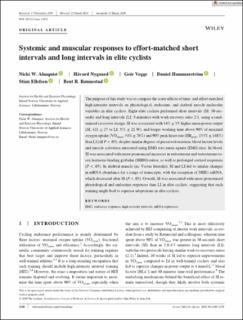Systemic and muscular responses to effort-matched short intervals and long intervals in elite cyclists
Almquist, Nicki Winfield; Nygård, Håvard; Vegge, Geir; Hammarström, Jens Konrad Daniel; Ellefsen, Stian; Rønnestad, Bent
Peer reviewed, Journal article
Published version
Permanent lenke
https://hdl.handle.net/11250/2728653Utgivelsesdato
2020Metadata
Vis full innførselSamlinger
Originalversjon
Scandinavian Journal of Medicine & Science in Sports. 2020, 30, 1140-1150. 10.1111/sms.13672Sammendrag
The purpose of this study was to compare the acute effects of time- and effort-matched high-intensity intervals on physiological, endocrine, and skeletal muscle molecular variables in elite cyclists. Eight elite cyclists performed short intervals (SI: 30-seconds) and long intervals (LI: 5-minutes) with work:recovery ratio 2:1, using a randomized crossover design. SI was associated with 14% ± 3% higher mean power output (SI; 421 ± 27 vs LI; 371 ± 22 W), and longer working time above 90% of maximal oxygen uptake (VO2max, 54% ± 76%) and 90% peak heart rate (HRpeak, 153% ± 148%) than LI (all P < .05), despite similar degrees of perceived exertion, blood lactate levels and muscle activation measured using EMG root mean square (EMG rms). In blood, SI was associated with more pronounced increases in testosterone and testosterone-tosex hormone-binding globulin (SHBG) ratios, as well as prolonged cortisol responses (P < .05). In skeletal muscle (m. Vastus lateralis), SI and LI led to similar changes in mRNA abundance for a range of transcripts, with the exception of NHE1 mRNA, which decreased after SI (P < .05). Overall, SI was associated with more pronounced physiological and endocrine responses than LI in elite cyclists, suggesting that such training might lead to superior adaptations in elite cyclists.
Beskrivelse
This is an open access article under the terms of the Creative Commons Attribution License, which permits use, distribution and reproduction in any medium, provided the original work is properly cited.
© 2020 The Authors. Scandinavian Journal of Medicine & Science In Sports published by John Wiley & Sons Ltd

